9 Most Common Types of Butterflies in Mexico (With Pictures)
-
Pete Ortiz
- Last updated:
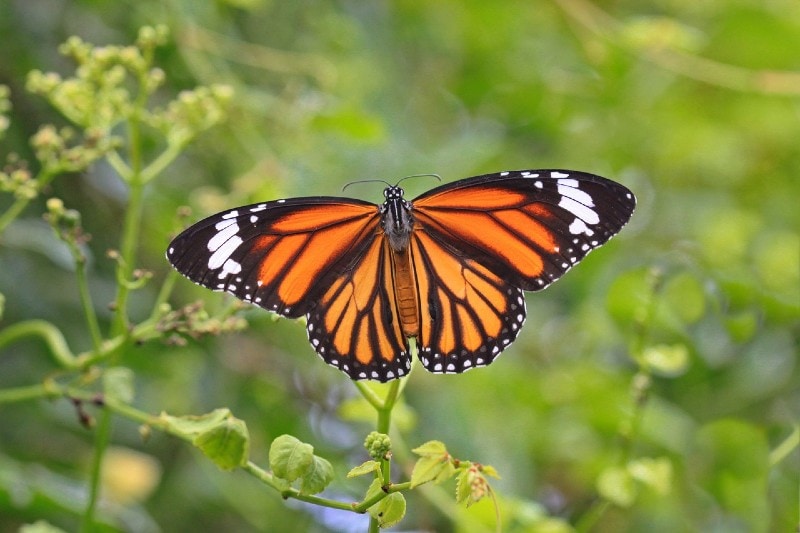
Mexico is home to hundreds of butterflies. The unique monarch butterfly migration creates one of the spectacular cultural wonders of Mexico. Seeing different sizes and patterns of butterflies painting the atmosphere with various colors is breathtaking. If you love watching butterflies in the neighborhood in Mexico, this article is for you. Here’s a list of Mexico’s 15 most common types of butterflies.
The 9 Most Common Types of Butterflies in Mexico
1. The Monarch Butterflies (Danaus plexippus)

Monarch butterflies are native to the North American tropics. This butterfly is one of Mexico’s most popular species famous for its colorful pattern migration. The identifying characteristics include:
- Adult Monarchs have a wingspan of about 4.5 inches
- The prevalent color is a stained-glass orange pattern with black veins
- Their larvae feed primarily on milkweed plants
- The lifespan of an adult Monarch is 3–4 weeks
- The special “Methuselah” generation can live for nine 9months
These butterflies are found near milkweed plants, which are the food source for their larvae. The population of monarchs has been declining in recent years, but their historical migration in mid-September each year continues to attract tourists.
2. Red Admiral (Vanessa atalanta)
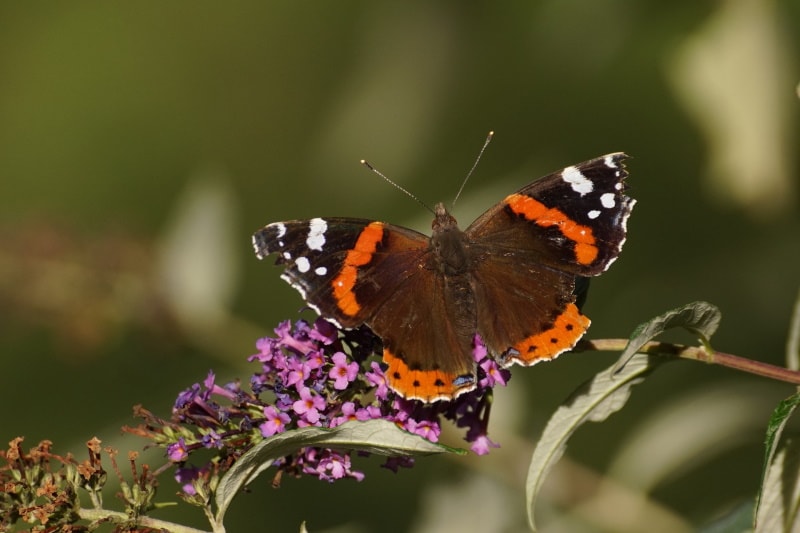
The red admiral is a robust and large butterfly belonging to the nymphalids family. It is the most widespread butterfly species in Mexico. You can find these butterflies mainly in moist habitats near forest edges.
This butterfly has the following identifying characteristics:
- Adults are large with a wingspan range of 1.75–2.5 inches
- Their underside back wings resemble a bark
- Their bodies are dark brown with white spots and a reddish circular band
- Their larvae are gray-pink to charcoal with white spots and have spines resembling hair
Do you want to attract red admirals? These species love fermented fruits; placing overripe fruit can attract them to your yard. They are easy to observe, calm, and more approachable than most butterfly species. These butterflies also land on human beings!
Admirals fly southwards in search of a warm climate and food in winter before relocating northwards during spring.
3. Painted Lady (Vanessa cardui)
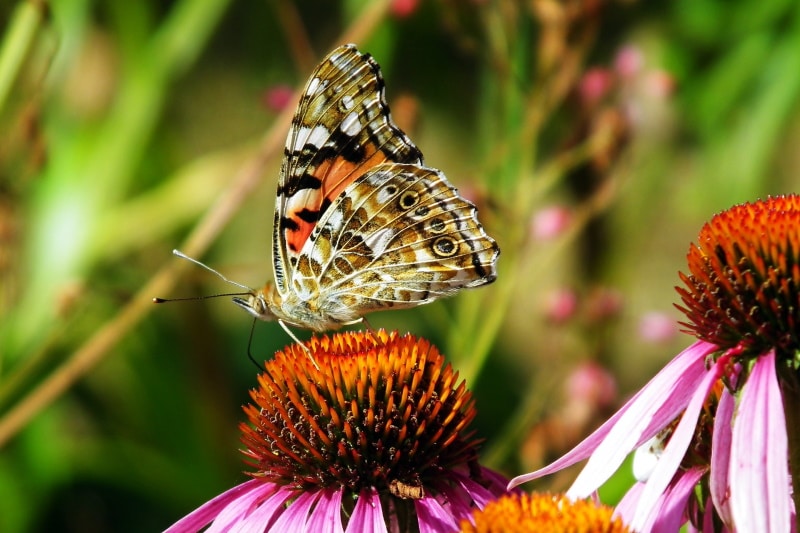
The painted lady, also called Vanessa cardui, is a long-distance migratory butterfly loved for the fantastic migration scenes in Mexico. They are mostly found in open and undisturbed areas in Mexico. These places include gardens, roadsides, and pastures. The butterflies migrate to New Mexico in spring.
These species exhibit the following characteristics:
- Painted ladies belong to the Nymphalids family
- Medium wing size
- A wingspan range of 1.75–2.5 inches
- Their larvae (caterpillars) have varying hues ranging from greenish-yellow to charcoal
- Adults have a pinkish-orange color complemented with dark brown or black marks near the wingtips with white spots within the black marks
This butterfly’s population varies in different years. For instance, you may fail to see them in one area one year before the butterflies show up in significant numbers the following year.
This species mates all year, thanks to the constant migration patterns that enable them to spend their entire lifetime in the best environments.
4. Viceroy (Limenitis archippus)

The viceroy is a brush-footed butterfly because of its tiny and hairy forelegs that resemble a brush. These butterflies, primarily found in Northern Mexico, exhibit the following characteristics:
- The viceroy’s wingspan ranges between 2.5–3.25 inches
- Adult Viceroys have deep orange coloration with black veins and edges and white spots inside the black border
- The viceroy’s larvae have a mixture of brown, cream, and green complexion
- The larvae also have two distinctive horns resembling knobby antennae
The viceroy is almost identical to a monarch. However, monarchs lack the black line on the bottom wing in viceroys. Besides, their larvae have a different appearance. Viceroys are not migratory butterflies, unlike monarchs. Viceroys live in marshes, meadows, swamps, and other wet areas in Mexico.
5. Hackberry Emperor (Asterocampa celtis)
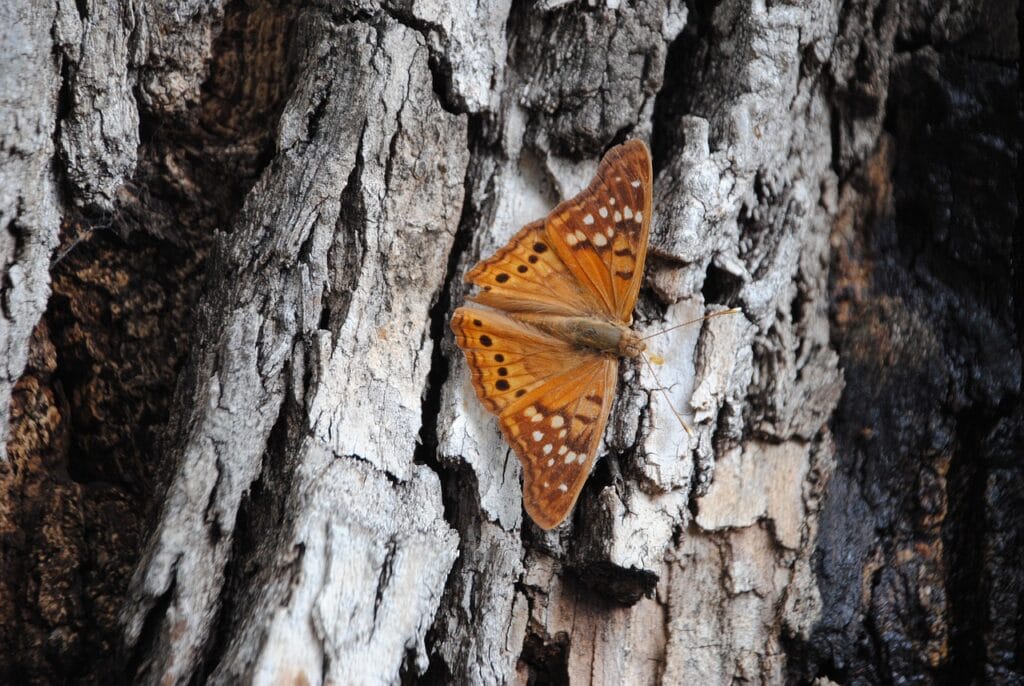
The hackberry emperor, popularly known as the hackberry butterfly, is a native North American butterfly found in Mexico. These butterflies can commonly hop around city gardens, parks, swamps, and water bodies. Hackberries also visit flowers that other butterfly species rarely visit.
The identifying characteristics include:
- A wingspan range of between 2.0–2.75 inches
- It exhibits an amber-brown pattern complemented with orange-ringed eyespots and several white and dark-brown spots
- Their larvae are light green with two back yellow, white stripes
- The caterpillars also have two short spines on the head and two tails
- Hackberry emperors feed on the leaves and buds of hackberry trees
These butterflies are quite peculiar as flowers rarely attract them. They find the minerals they need for survival in many unusual places, including rocks, soil, sap, dung, and pavements. They even often land on humans near them to ingest sodium from human skin. Their lifespan is between 6–14 days.
6. Red-Spotted Purple (Limenitis arthemis astyanax)

The Red-spotted purple butterfly has a blue coloration with red to orange marks on the tip wings. At first glance, you can confuse it with a swallowtail, but it has no tail. Its shape and color mimic poisonous pipevine swallowtails and serve as a defense mechanism against predators.
The butterfly’s distinguishing characteristics include the following:
- Wingspan ranges between 3–4 inches
- Mottled cream, brown, and yellow caterpillars with angular body sections
- Caterpillars exhibit twig-like horns
The red-spotted purple’s shimmery dark-purple colors complemented with red-orange spots allow the butterflies to stand out as the most beautiful butterfly species in Mexico.
One of the amazing features of these butterflies is that the same species members can look completely different. For instance, it is called the white admiral in the northern range where there is no pipevine swallowtail.
Red-spotted purples feed on sap, carrion, and rotting fruits. You can attract them by placing a cut orange in your yard.
7. Mourning Cloak (Nymphalis Antiopa)
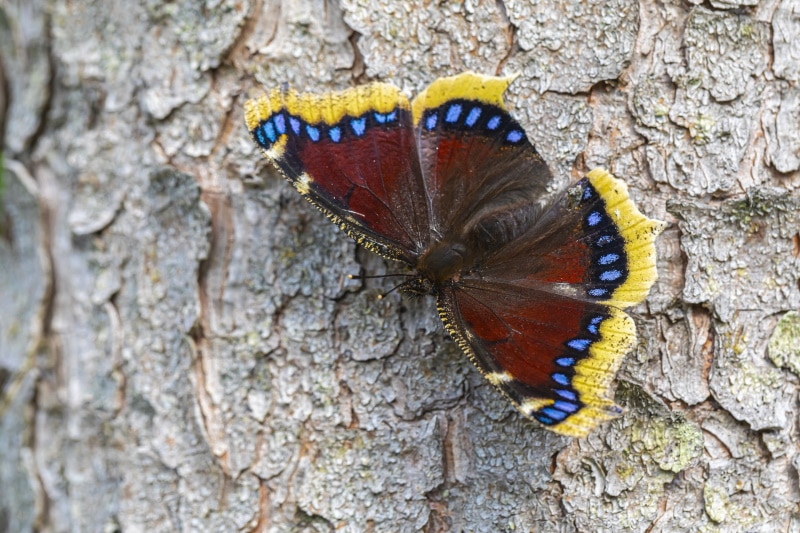
The mourning cloak is a long-lived butterfly that lights any landscape. These butterflies can live up to ten months, making them one of the butterflies with the most extended lifespans. Distinguishing characteristics include:
- A wingspan range of 3–4 inches
- The butterflies are more active in temperatures of about 60°F, making them prevalent in spring
- They overwinter in protected areas such as building crevices, logs, and bark
- Adults are black with an iridescent sheen and a yellow border and purple spots
- Larvae exhibit a black coloration with rows of red spots and white specks on their backs
These butterflies inhabit deciduous forests, parks, suburban yards, and golf courses. However, they are not abundant, unlike most butterfly species.
The species prefer rotting fruit and tree sap to nectar and feed on early blooming shrubs and willows. The males defend vast territories extending beyond 300 square yards. Their preference for cold weather and solitary makes them difficult to spot, even for keen butterfly enthusiasts.
8. Pearl Crescent (Phyciodes tharos)
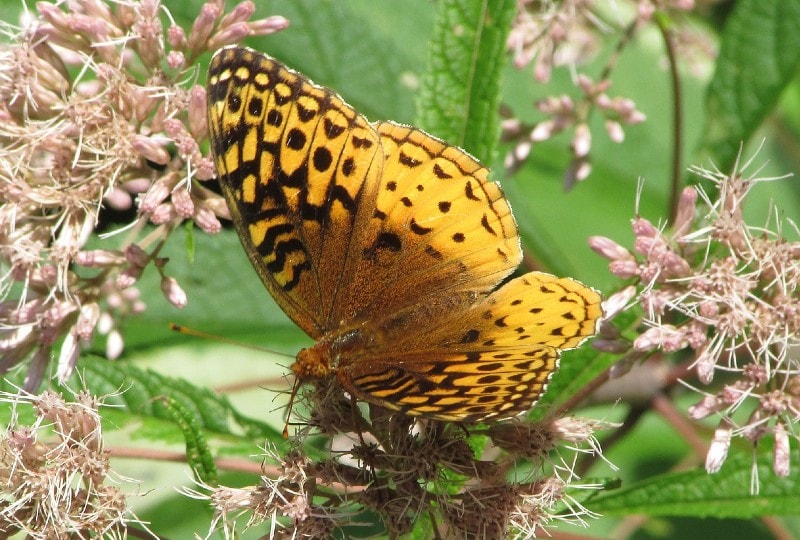
The pearl crescent is also in the brush-footed (Nymphalidae) butterfly family. These butterfly species are the most abundant in Mexico and the United States in general.
Some of their notable characteristics include:’
- A wingspan between 1–2 inches
- Orange wings with black borders
- Larvae covered in spines for defense
The butterflies derive their name from the light-colored crescent-shaped spot with a dark surrounding patch on the outer edge. Their first pair of legs are short with a hairy appearance.
They lay eggs in clusters of up to 200 under the food plant’s foliage in early April. They like moist grounds, mainly sunny and open habitats. They will inhabit common areas like gardens, fields, forest edges, and meadows.
9. Question Mark (Polygonia interrogationis)
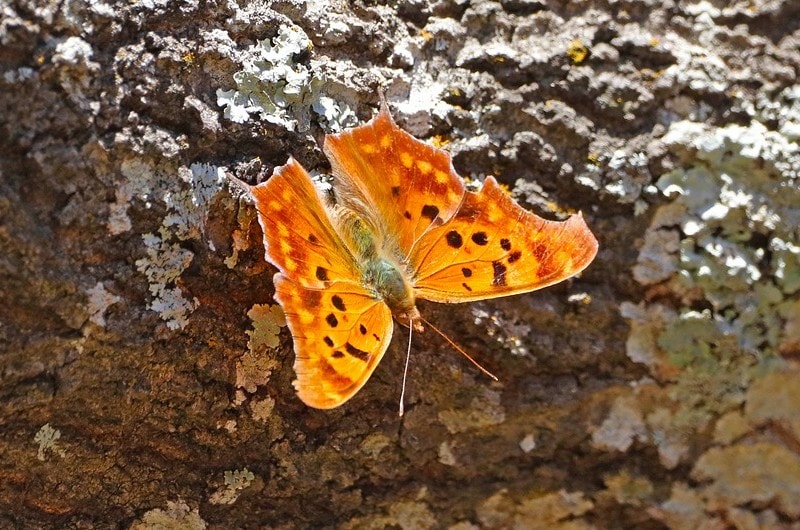
The question mark is a beautiful black and orange-hued butterfly characterized by its sharp angled wing margins and short tail-like projections. The butterfly derives its name from the light-colored marking on the underside of its wings that resembles a question mark. Its underneath is mottled brown and resembles the hoary comma and eastern comma butterflies.
Notable characteristics include:
- The wingspan range is between 2.25–3 inches.
- Most butterflies have deep orange bodies with black spots and a lavender hedge
- Their larvae have a gray-black hue with orange cream stripes and spines
- They resemble dry and dead foliage with their wings closed
This species is mostly found in moist woodlands, parks, swamps, and residential spaces in different parts of Mexico. They feed on nectar from plants such as elm, hops, nettle, and hackberry, thus they mostly thrive in thick forests.
In Conclusion
There are several other types of butterflies in Mexico; our list covers only a handful. Other common butterflies in Mexico include the clouded sulphur, cabbage white, black swallowtail, banded hairstreak, coral hairstreak, and gray hairstreak. You can enjoy the sight of migratory butterflies or attract some to your garden if you’re a butterfly enthusiast.
Featured Image Credit: gyulche1, Pixabay
Contents



